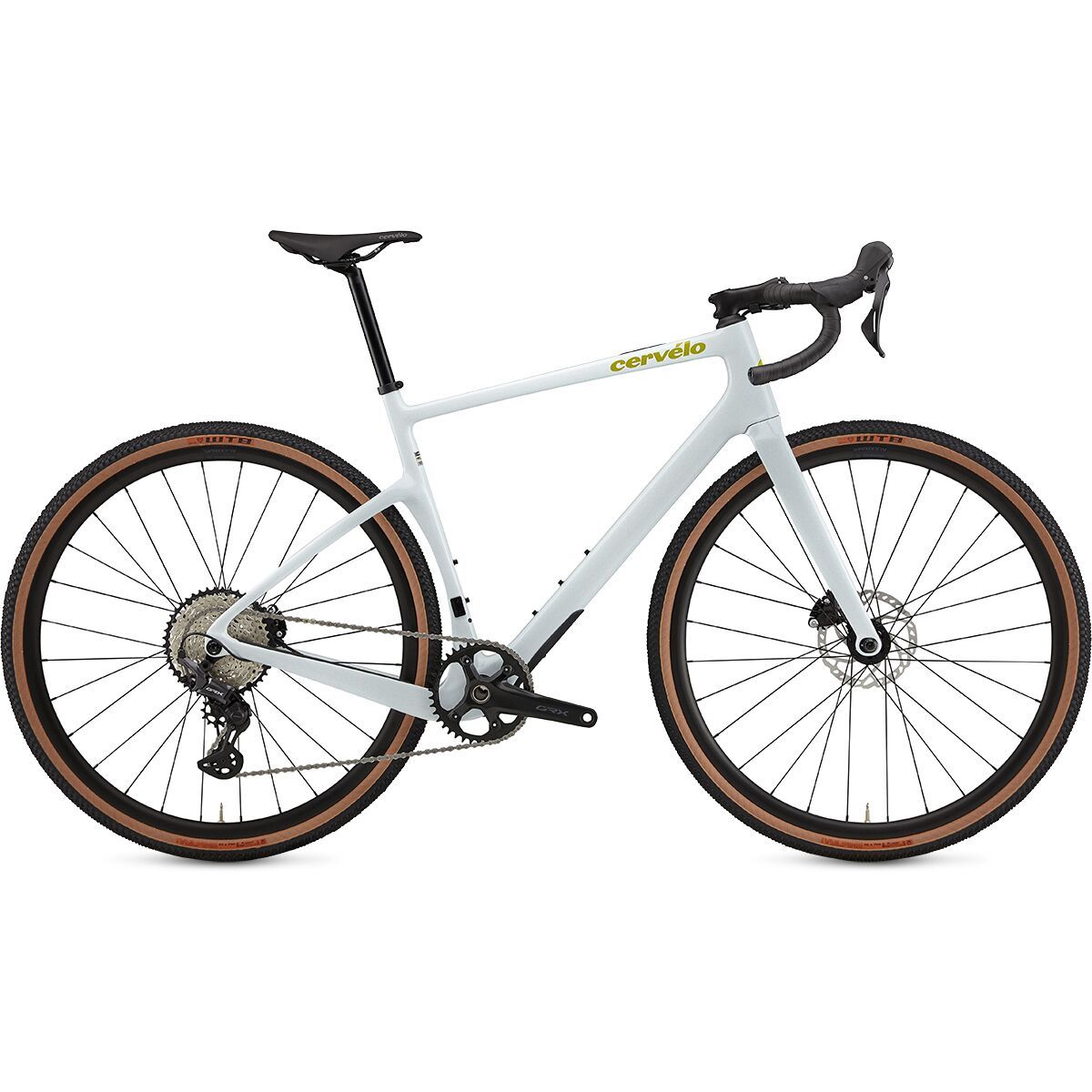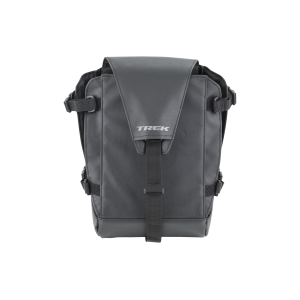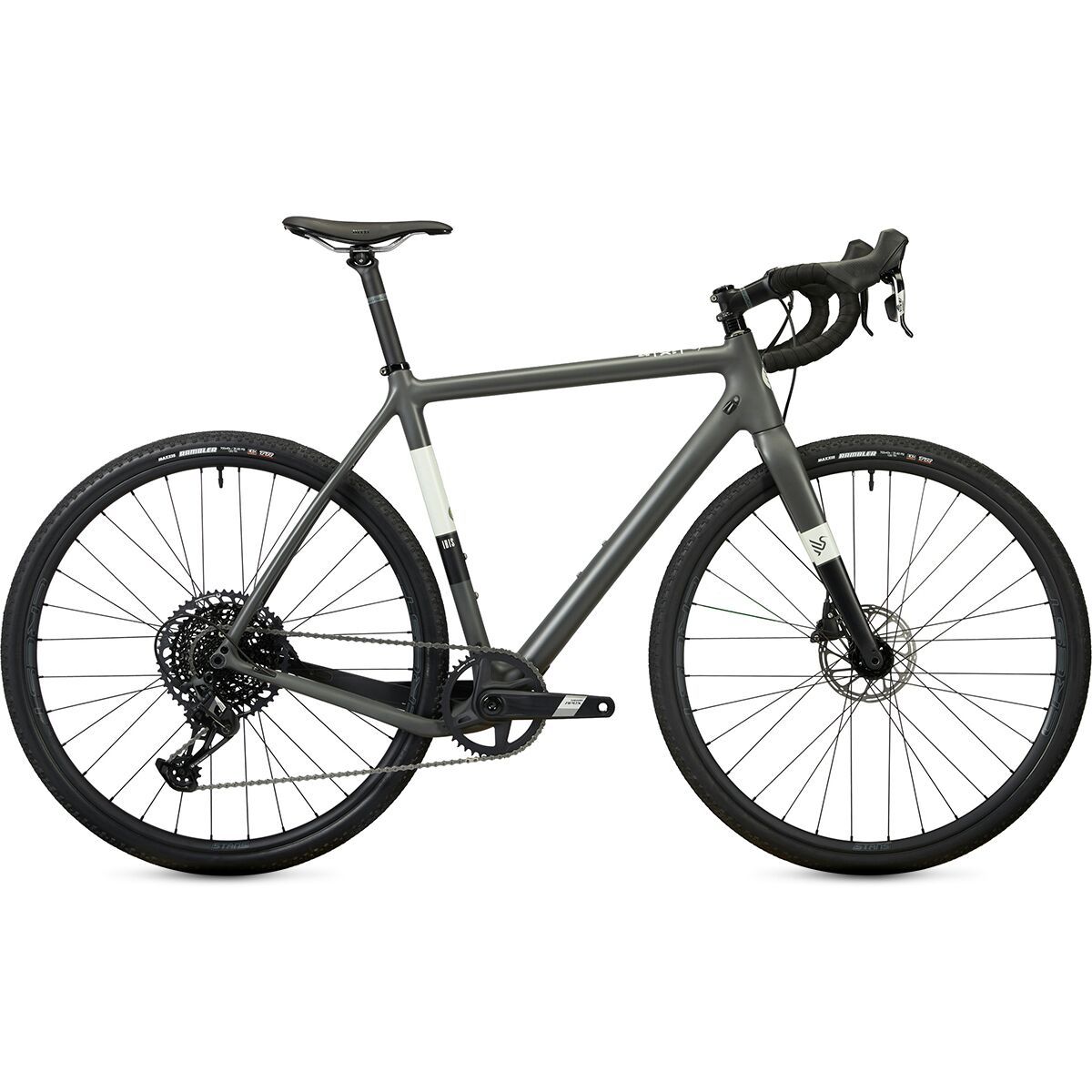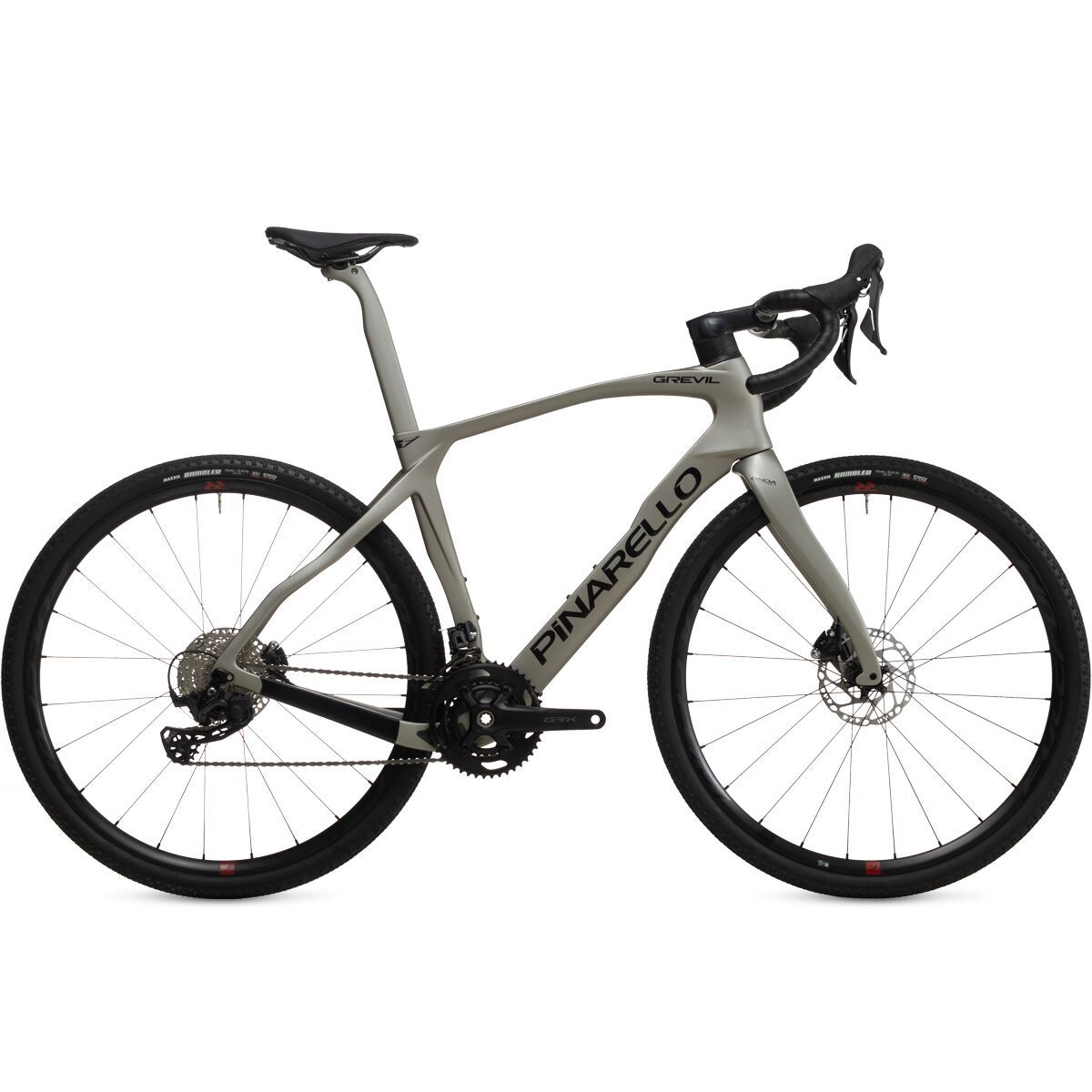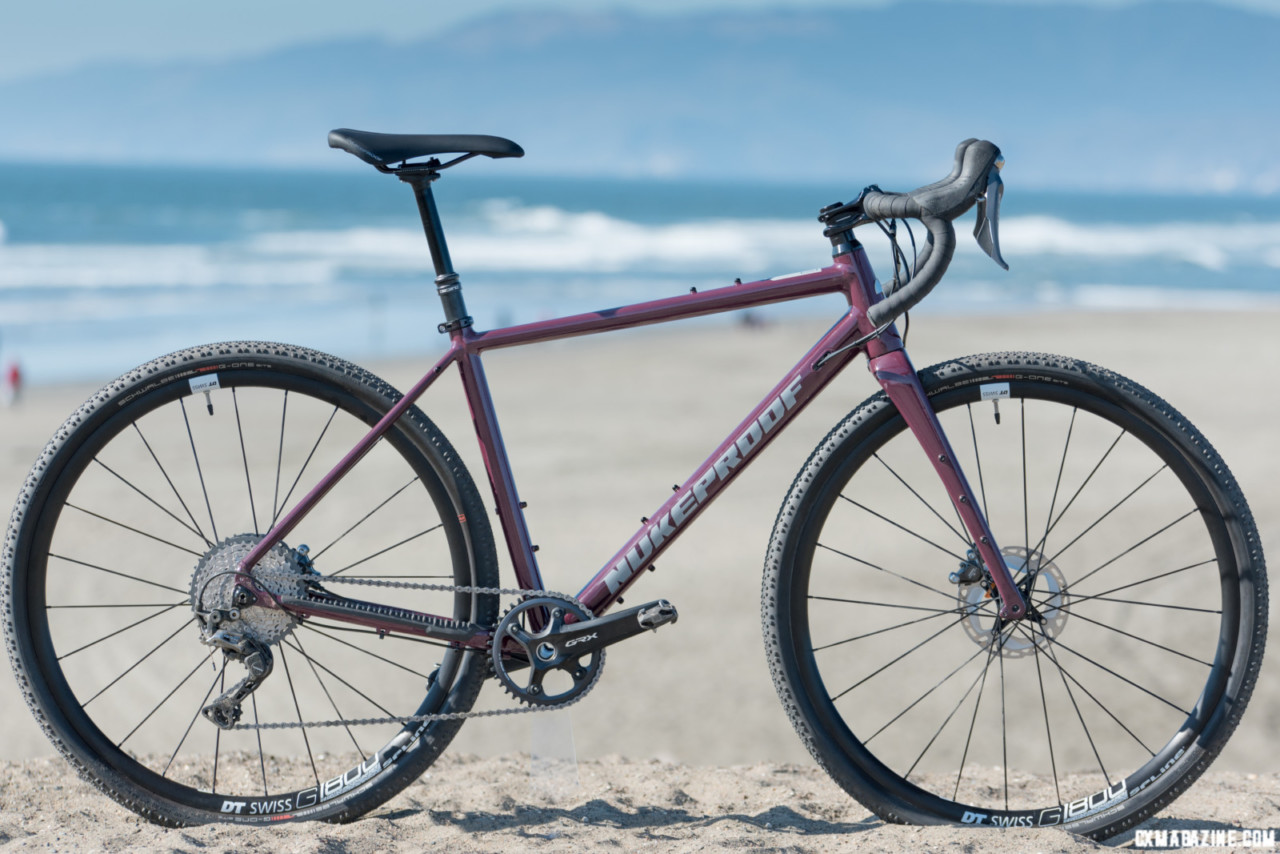
Nukeproof Digger Adventure Bike. © C. Lee / Cyclocross Magazine
Nuke Proof is an ionic brand from 1990, a pioneer of the use of titanium and carbon fiber, then considered exotic materials for mountain bikes. The company offered carbon-bodied hubs that many of us drooled over.
The mountain bike boom faded at the end of the 1990s and Nuke Proof Industries headed into the sunset with it. Michael Cowan, a Northern Ireland downhill racer saved the brand and reinvigorated the company as Nukeproof. By the mid-2000s Nukeproof was back in the news with a new bike competing in the World Cup.
Nukeproof is still primarily a mountain bike brand with a focus on downhill and enduro bikes. In 2017, 2018 and 2019 Sam Hill, the downhill world champion from a decade earlier, won the Enduro World Series overall title on a Nukeproof bike with Nukeproof components that have his design input. In 2022, Nukeproof, now owned by WiggleCRC, the U.K. e-commerce retailer, re-entered the U.S. market.
The Digger is Nukeproof’s drop-bar bike that also has design input from Sam Hill. The design features befit rides with moderately technical descents. The original Nukeproof Digger was an Aluminum drop-bar bike with 650B wheels that did not stand out in any particular way. The redesigned 2022 Nukeproof Digger that I had the chance to ride and review changes the game considerably.
Bigger Wheels, Slacker Geometry
The title sounds like a heading for modern mountain bike design. The 29-inch wheel now dominates every mountain bike discipline and mountain bike geometry shifted to more steering trail in the past decade. The Nukeproof Digger incorporates these design features for the 2022 redesign. Recently, we reviewed the Evil Bikes Chamois Hagar which also exhibits these modern mountain bike parameters, and I put the Nukeproof Digger in the same category.
The 2022 Nukeproof Digger has TIG welded 6060-T6 hydroformed aluminum tubes. The included fork is all carbon with a 48mm offset. Notably, the headtube angle is 69 degrees, and combined with the included fork, the calculated trail is 86.2mm, about a centimeter longer than the previous version which was more typical for gravel and cyclocross bikes at around 76mm. Our review bike is a medium size that has an effective top tube length of 58cm and a 419mm reach. All combined, the front center is a rangey 663mm. That geometry puts the front wheel further out in front of the rider. The bottom bracket drop is 70mm with 43cm chainstays that are flattened and bowed offering 45mm of recommended maximum tire clearance with a 700C wheel. If you choose to use 650B wheels, the maximum tire recommendation is 47mm. The total wheelbase is 108.3cm. A curious parameter for an adventure-oriented bike is the short 150mm headtube yielding a low 561.6mm stack height. That might be fine for some riders, or if the fork steering tube was longer. The safe length of the unsupported carbon steering tube above the top headset race has many contributing factors and is a limiter when compensating for a low stack height.
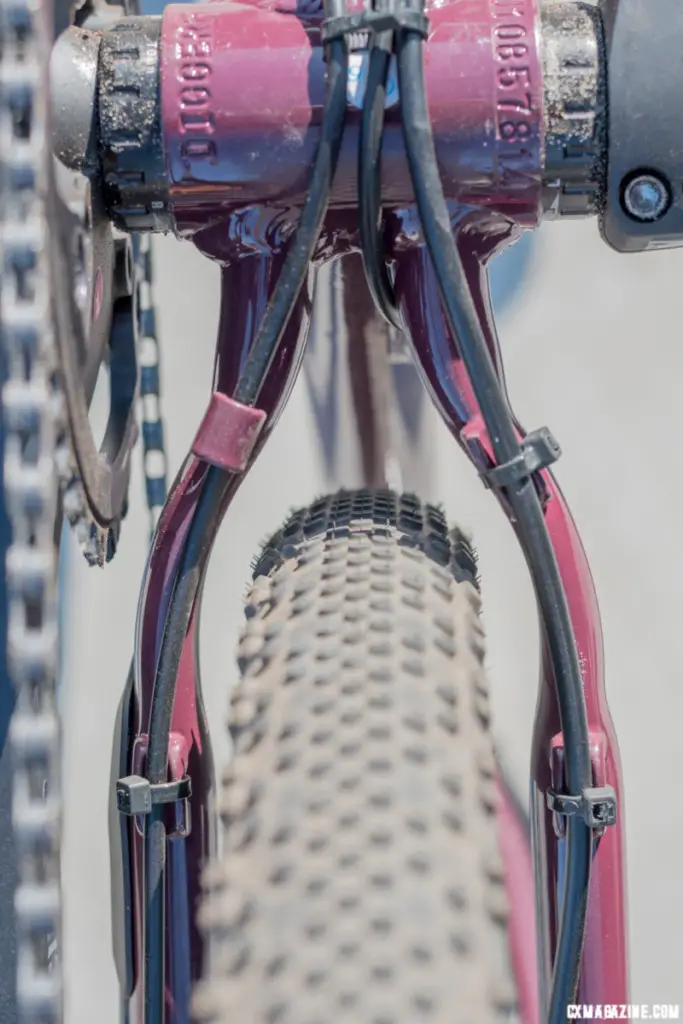
Ample tire clearance, shown with a 45mm tire. Note external control lines and 68mm BSA threaded BB. © C. Lee / Cyclocross Magazine
The seat tube angle is 74 degrees, so the saddle position will not be too different from other bikes relative to the bottom bracket. One of the best features is the use of a standard 68mm BSA threaded bottom bracket shell. An adventure bike would not be complete without mounting points, and the Digger has provisions for 4 bottle cages on the main triangle and a triple bolt mount on each fork leg. Fender and rack mounts are also present. Control lines run internally through the downtube and left fork leg only. The down tube control lines, including dropper post cable housing, exit at the bottom of the tube. The rear derailleur cable and rear brake hose are external to their destinations, the dropper cable enters the seat tube to actuate the dropper internally. Brake calipers use the flat-mount standard. Axles are 12X100mm TA front and 12X142 TA rear.
The Build
Our medium size sample is a mid-level build with a Shimano Rx 810 GRX 1X mechanical drivetrain with a 40T chainring and 11-42 cassette yielding a slightly lower than 1:1 low gear of 0.95 or 25.7-inch gear. Every model comes with 700C wheels this year, though 650B X47 will fit.
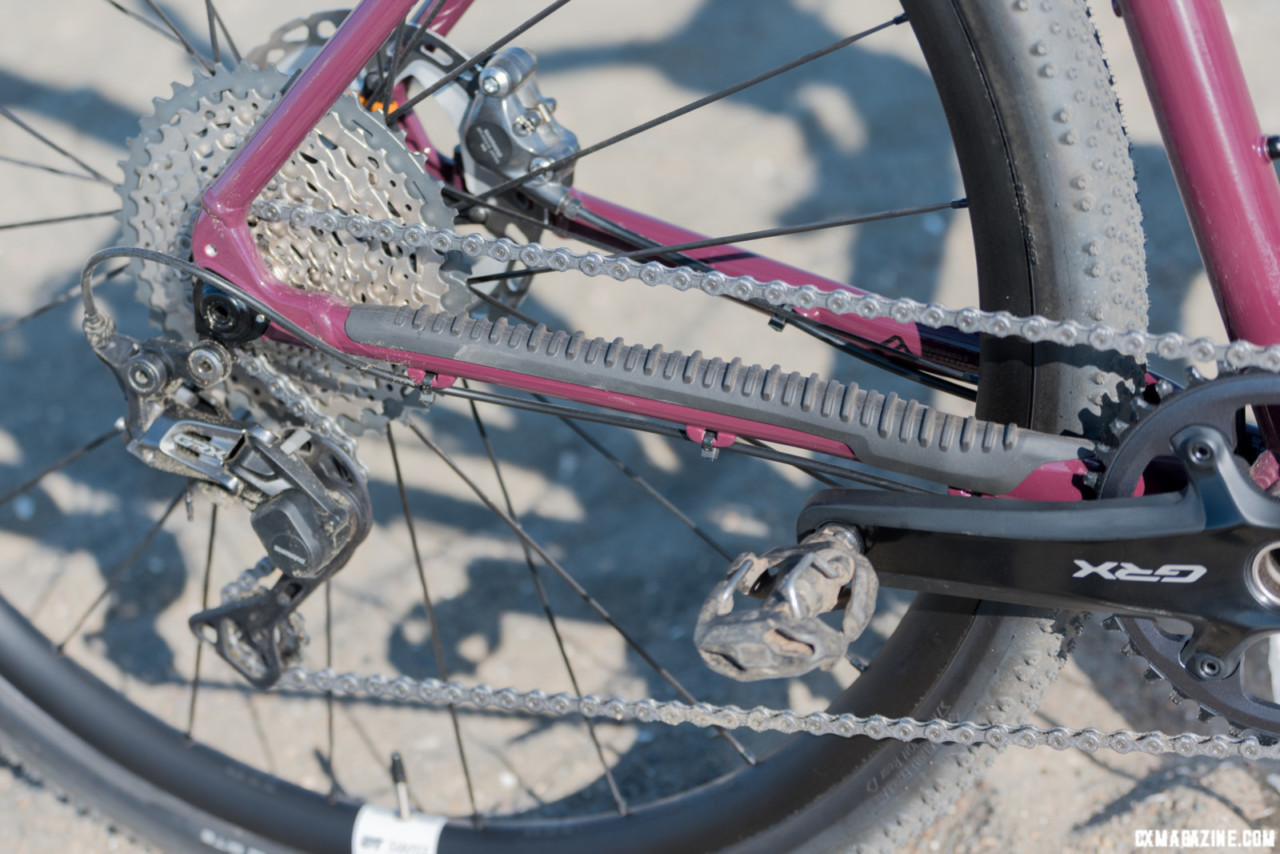
Ribbed for a more pleasurable ride. © C. Lee / Cyclocross Magazine
The use of the Shimano RD RX812 for 1 x frees the left GRX 810-LA lever to actuate the dropper post. This left hydraulic dual control lever is specifically for dropper actuation with no shift release button and enough cable pull for the average dropper post.
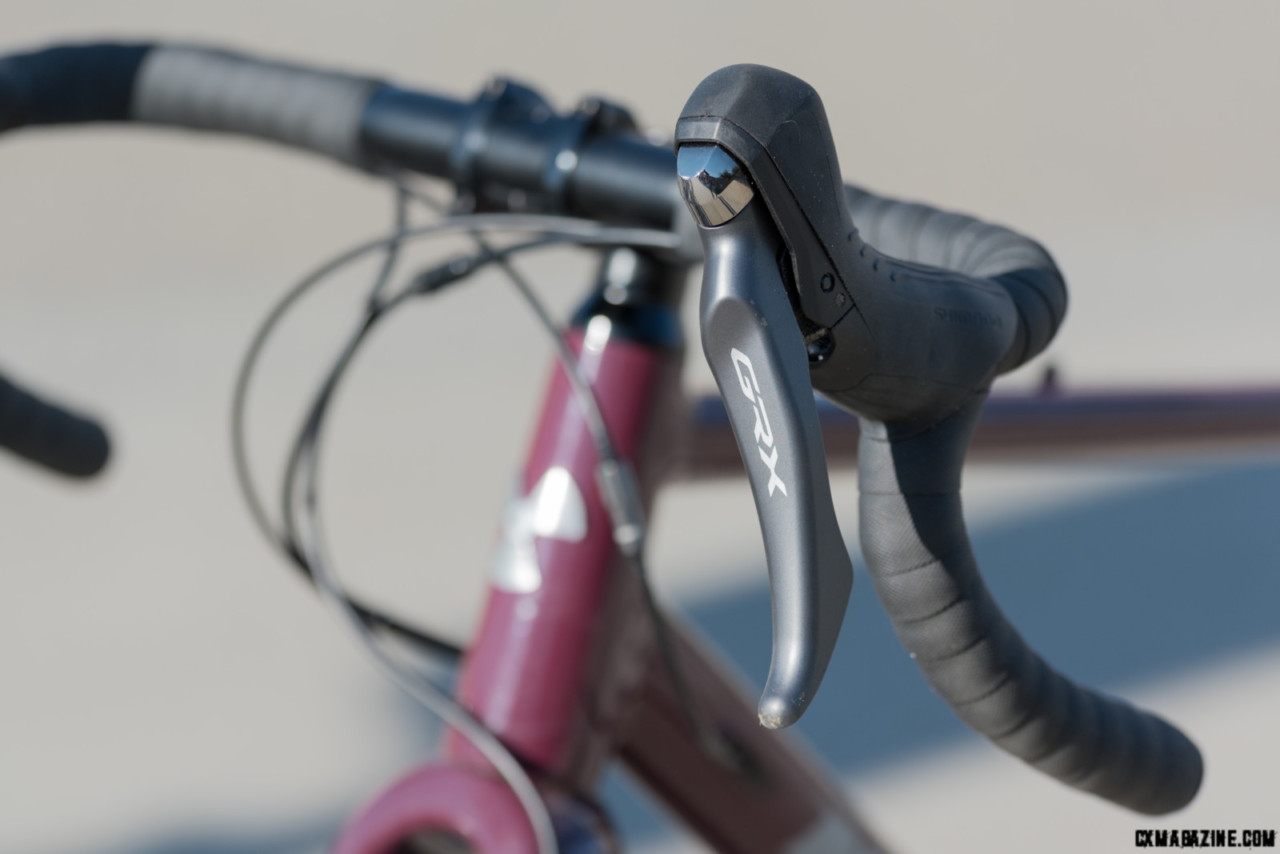
The Shimano GRX 810-LA left lever is a dedicated dropper lever. © C. Lee / Cyclocross Magazine
Shimano GRX 810 brake calipers for flat mount and matching RT 800 160mm rotors complete the control components. The included dropper post is a Brand X Ascend internal control post with 125mm of travel and a 31.6mm diameter. A beautifully machined aluminum robust 6mm Nukeproof Horizon stem attaches the non-branded 46mm wide (at the hoods) flared aluminum bars.
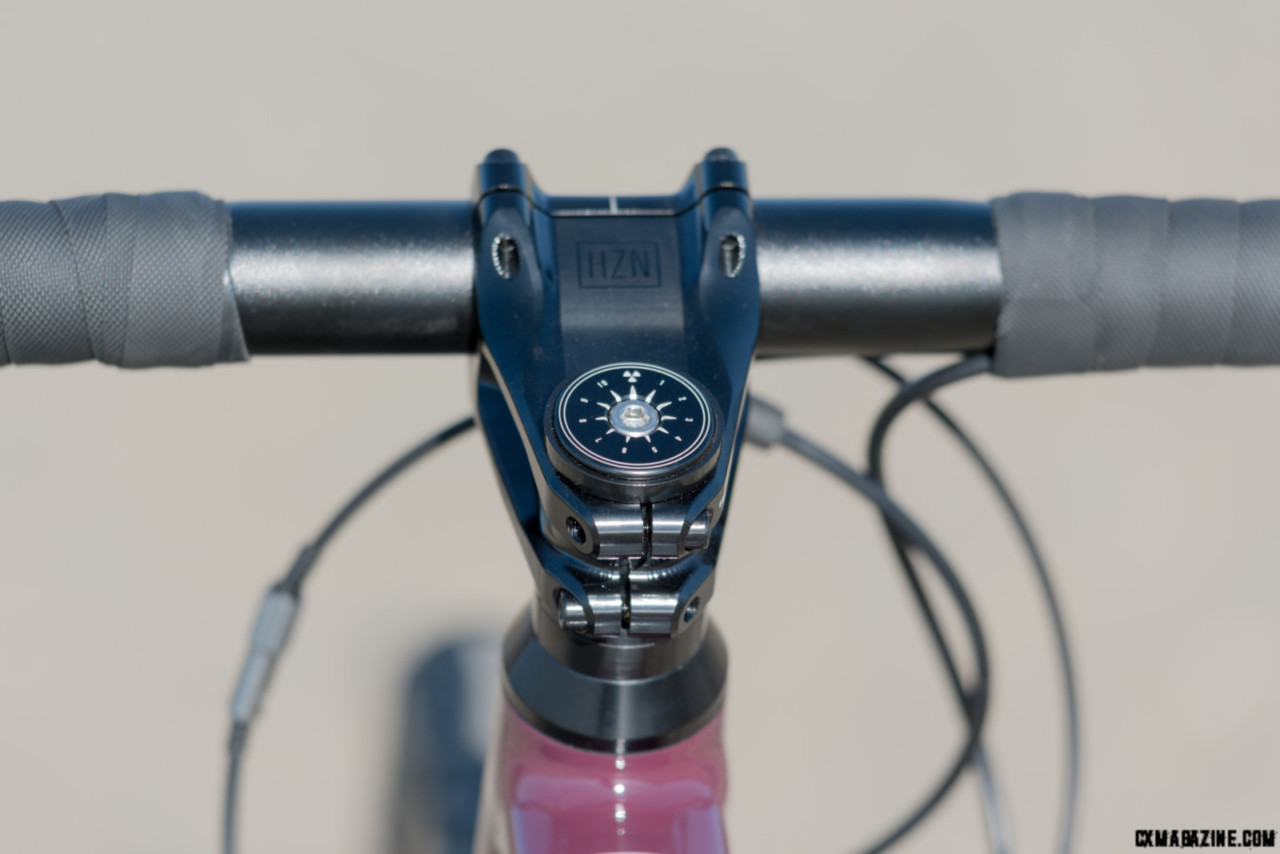
Nukeproof Horizon stem, 6mm. © C. Lee / Cyclocross Magazine
The saddle is Nukeproof branded, as is the external seat post clamp.
Wheels are entry-level DT Swiss G 1800 Spline 25 with aluminum rims and 370 center lock hubs that use standard pawls as opposed to the star-ratchet mechanism of the higher-end DT Swiss hubs. 24 X2 interlaced, straight pull bladed DT Swiss spokes hold the 24mm internal width hooked rim. 1800 refers to the approximate weight as these wheels come in around 1900 grams. The 45mm Schwalbe G1 Bite tires are a good choice for this bike but come with tubes installed for the showroom floor.
Put together, the Nukeproof Digger medium with the “Factory” build weighs 23.4 pounds, exactly as advertised! We like truth in advertising.
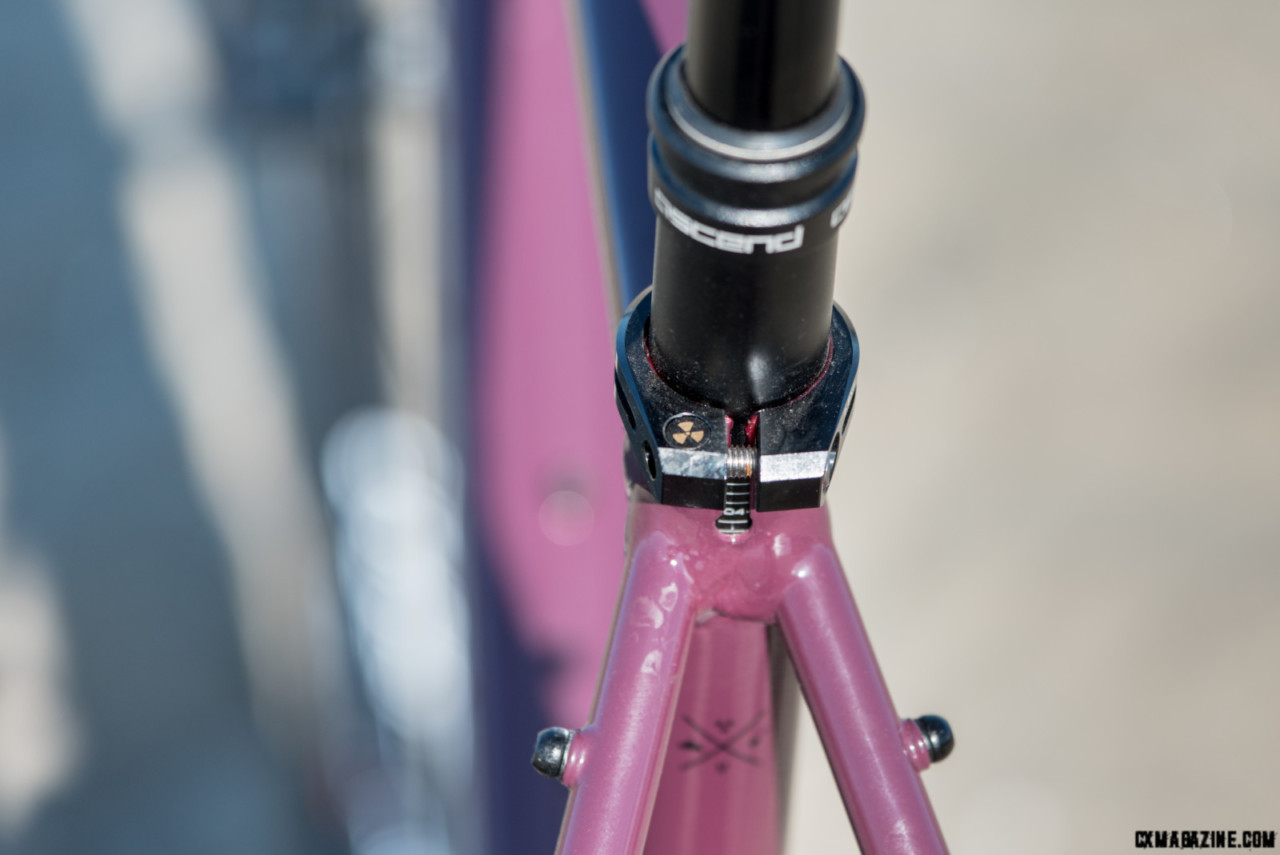
Nukeproof branding details on the seat clamp. © C. Lee / Cyclocross Magazine
The Ride
I’ll admit I’m a bit of a weight weenie as an old-school racer. We have come to learn that bike weight is less of an issue than aerodynamics in most situations and the percentage of combined rider-plus-bike is small per pound. That said, the bike is not heavy, but you know it’s over 20 pounds when you pick it up. Depending on what the Nukeproof Digger is compared to, it is sluggish in a sprint and not snappy on a climb. It is a smooth ride that feels planted.
For some of the review riding, I decided to go tubeless and then change the wheels to remove a pound or so because I had the luxury to do so. I like 700C wheels, and 45mm seems like plenty wide to me for most non-mountain bike pursuits. 700C X 45mm is the largest recommended tire size, and the 650B maximum is only 2mm wider, which yields a smaller wheel overall. If you want to match the diameter, a 27 (650B) X 2.2-inch tire (56mm) would be closer but is an unrecommended tight fit in the Digger. All that said, I could easily fit a 700 X 50mm mildly knobby tire into the Nukeproof Digger without much worry, but a knobby tire like the WTB Raddler 700 X 44 is fine for most terrain you’d take even this drop bar bike.
The gears are a standard gravel adventure range and low enough for most terrain. Perhaps you’d want lower if bike packing in hilly terrain. I had commented about Shimano’s GRX in a review of the Trek Boone a year ago. The GRX crank is offset out by 2.5mm, biasing the chain line outboard. That means a less efficient, noisier chain in lower gears and a tendency for the chain to crawl off the large cog if the chain becomes dirty and dry or when backpedaling.
Although the 419mm reach is long, the short stem compensates. However, the 561.6mm stack is short, and only 65mm of steerer is above the relatively short 150mm headtube. This leaves 70mm of drop from my saddle to the bar at my full saddle height. That is a road racing position and a bit low for an adventure bike in my opinion. Sizing up to an L yields a 20mm higher stack, but that still leaves the bars 50mm below my saddle when it is at maximum height, and the already long reach increases by 25mm, an extra inch.
I took the Nukeproof Digger over a wide variety of terrain that on the extreme side included sections of rocky mountain bike trials with long steep stretches that pitch over 25% with two short 30% downhills. That is where the long, slack front end and dropper post offer the most significant advantage. I may have walked these sections on my ‘cross bike, but with the dropper down and the front wheel out in front, I had enough confidence to ride the steep downhill. The consequence of that geometry is front-end-wander or wheel flop on steep uphill sections. The Digger’s low stack height helped shift my weight forward, keeping the bike on track. However, this does not negate my preference for a higher bar position.
The Digger excels over changing surfaces. In a ‘cross race, the transition from pavement to a soft surface does not push the front wheel off line as sometimes happens with bikes with steeper head angles, or handlebars further over the front wheel. The Digger drives a straight line through the sand despite its name. On a chunky gravel path, the front does not get jostled about by the rocks.
To compare the Nukeproof Digger to the Evil Chamois Hagar, since both have the same intention, I was able to ride them on over the same courses on consecutive weeks. The Nukeproof Digger is 5mm less slack, with a 10mm higher bottom bracket, and a smoother ride (with essentially the same tubeless tire setup). The stack height of the Chamois Hagar is 35mm higher than the Digger. As reviewed, the Digger is over 3 pounds heavier but only 1/3 the price! Of course, you don’t get the luxury of wireless shifting and dropper actuation, nor the reduced weight of all carbon components that you’d pay for with the Evil Chamois Hagar review bike. The difference in front-end geometry is subtle and subjectively biased by knowing the difference. Both offer that downhill confidence, but the Nukeproof Digger does not require as much effort to stay on line when climbing steep grades. I mentioned the lower stack, but perhaps that 5mm less trail plays a role. I had a couple fewer pedal strikes with the 1cm higher bottom bracket of the Digger, but a remount after a run definitely felt higher as well.
Shimano GRX mechanical shifting is mostly reliable, the chain line comment above notwithstanding. I like the smooth one-lever dropper post actuation of the GRX 810-LA. It is convenient and reliable with the Brand X Ascend post. I also like Shimano’s hydraulic brake performance in general, with either Shimano’s organic or metallic brake pads. GRx levers have angled flat sections offering comfortable finger placement and grip when you are braking with your hands resting on the hoods. This is where I often find my hands on the Nukeproof Digger with the short stack. With Shimano GRx hydraulic brakes and levers, I feel confident braking from the hoods even if the steep section is somewhat long. Flat mount calipers and 160mm rotors provide enough power and modulation for the traction of the 45mm tires I used.
DT Swiss 1800 Spline 25 are great entry-level wheels for this application. The 25mm internal width is appropriate for the 38-45mm tires you’d use with the Digger and the wheels take abuse with aplomb. Weight is a huge demerit for this wheelset. I understand that this name-brand wheelset helps the Digger meet a price point. I like the general-use tread of the Schwalbe G-One Bite tires, the casing resists cuts and in combination with the DT Swiss wheels, set up tubeless quite easily. Going tubeless immediately saves a quarter pound even with the weight of sealant, but changing to a lighter wheelset is the performance upgrade needed.
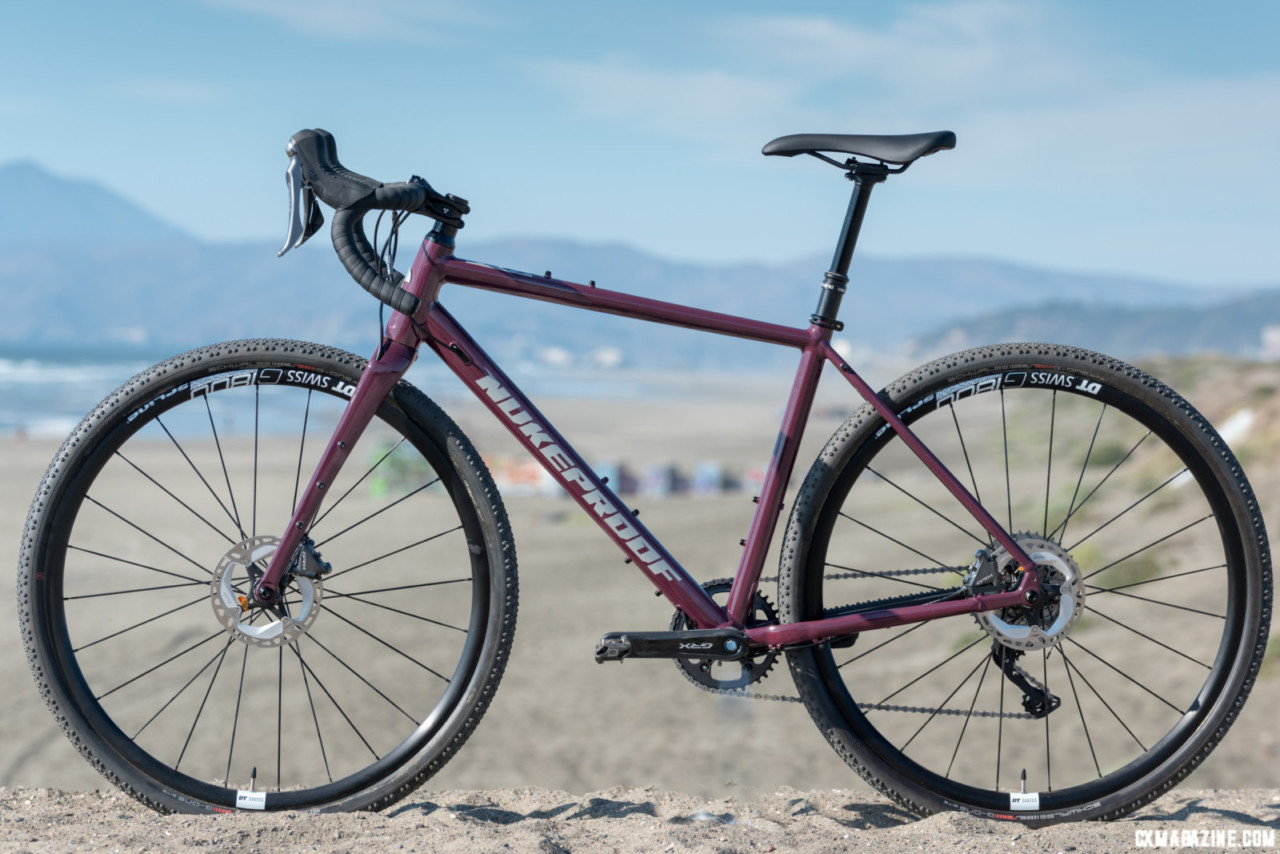
Nukeproof Digger Adventure Bike. © C. Lee / Cyclocross Magazine
The Verdict
The Nukeproof Digger is a fun bike to ride. It is appropriately equipped right out of the box, including a dropper post. I wish for a higher stack height, but that did not stop me from having a lot of fun riding the Digger. On unknown trails you encounter on a true off-road adventure, the Digger’s stout build, geometry and equipment give you a lot of confidence that you’ll be able to ride through many technical situations. One performance upgrade that will improve the already fun factor is a lighter set of wheels such as the Hunt 35 X-Wide for less than a grand, or the new Lōgōs Components Epoché for just over that (review coming).
2022 Nukeproof Digger Bike Specs:
MSRP: $2900 USD
Frame: 6060-T6 Aluminum
Fork: Nukeproof Carbon 48mm offset
Weight: 23.4 pounds, as tested with no pedals; 11.1lbs without wheels or pedals
Shifters: Shimano GRX 810/ 810-LA hydraulic mechanical 11 speed, dropper post specific
Crankset: Shimano GRX 810 40T single chainring
Brakes: Shimano GRX Shimano RT-800 rotors 160mm front, 160mm rear
Cockpit: Nukeproof Horizon 6cm stem, 46cm bar, aluminum
Seatpost: Brand X Ascend dropper, 125mm travel, 31.6mm diameter
Saddle: Nukeproof trail, steel rails
Wheels: DT Swiss G 1800 Spline 25, 24mm inner width aluminum
Tires: Schwalbe G One Bite 700X45 tubeless compatible
Warranty: 5 years, frame and fork
Country of origin: Taiwan
More Info: nukeproof.com














